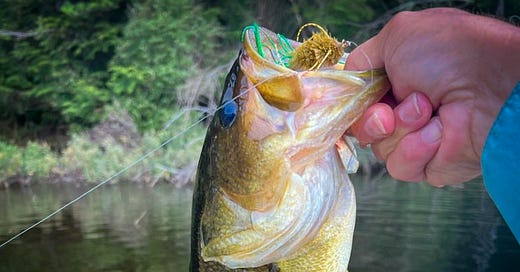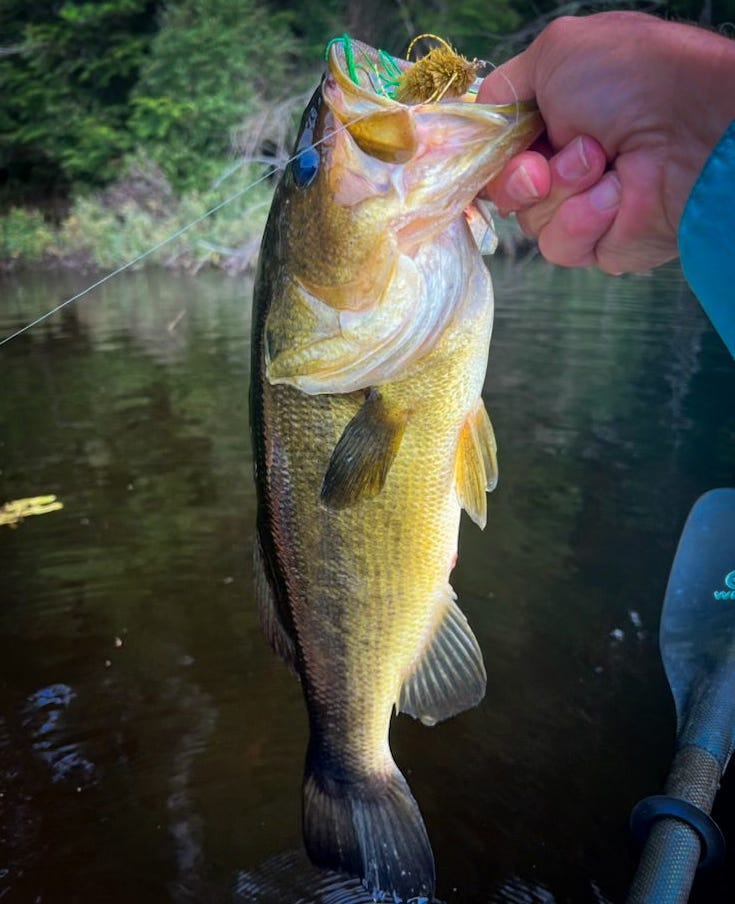I was recently reminded of Elizabeth Bishop’s “The Fish” while teaching my nonfiction high school writers. They had read the poem in their poetry workshop, after I suggested it to their teacher, and as they love to do, they were critiquing it, some of them complaining that it was too long and even repetitive. While, as always, I admired and appreciated them for their willingness to passionately discuss literature, my love for Bishop as a poet made me want to return to the poem and think more deeply about why I love it so much.
It’s a longish poem, but do take a few moments and read it, preferably out loud:
The first thing I notice after reading through the poem several times is Bishop’s voice, which is so instantly recognizable. Her poems are always infused with such a tender, deeply intelligent, always-probing, quiet intensity. As always, I also notice the clarity of her imagery—and in this poem, one gets the sense that she is working especially hard to make the imagery still more concise and clear, to take this lone, “tremendous fish” and say all there is to say about it, “to catch it,” as it were, with language, with poetry.
The first four lines of the poem, however, are simple, direct, straightforward. They could be the beginning of an essay or story or novel. Nothing about them feels particularly “poetic.” “I caught a tremendous fish/and held him beside the boat/half out of water, with my hook/fast in the corner of his mouth.” With “He didn’t fight./He hadn’t fought at all,” the poem subtly shifts toward the poetic, the “weight” of the fish starting to become a different kind of weight—a sense that it is something heavy with potential poetic meaning.
In the next several lines, the poem’s first similes appear (and here students were bothered that the word “wallpaper” is repeated): “…his brown skin hung in strips/like ancient wallpaper,/and its pattern of darker brown/was like wallpaper.” I find this repetition, however, to be precisely the thing that launches her into such a long, richly associative way of considering the fish, both its outward appearance and even its insides—that “coarse white flesh/packed like feather” and “swim-bladder/like a big peony.”
She seems suddenly amazed that both the way the skin hangs “in strips” and its patterns are both like wallpaper. The one simile occurs to her—that it hangs as wallpaper might when you put it up on a wall “in strips,” just as she notices that the same simile also works to describe its patterns of dark browns. I would argue that this repetition emphasizes how one association—wallpaper—emerges from the same exact thing—the shape and patterns of the fish’s skin; and from here, this double-duty simile launches her into looking at all the other things the fish somehow brings to mind.
Note how the patterns of the skin, which at first simply repeat “like wallpaper,” is extended after the colon to “shapes like full-blown roses/stained and lost through age.” Here she begins to work to refine her associations, and this is what awakens her deep interest in the fish, her desire to examine it so closely. She notes his barnacles, which transform into the metaphor “fine rosettes of lime.” The weeds attached to it become “rags of green weed,” another metaphor. A close look at the gills reminds her that the fish is suffering, “breathing in/the terrible oxygen.” But she turns quickly from her moment of empathy and thinks of the gills in another context; they are now “frightening…/fresh and crisp with blood,/that can cut so badly—” She turns from the fish’s suffering to the danger one might face while cleaning a fish—the need to take care around the gills lest they harm you.
And here she momentarily turns from just looking at the fish to imagining things she can’t see, but rather things that she “thought of,” having caught and cleaned and eaten fish in the past—landing on the poem’s fifth simile, that “pink swim-bladder/like a big peony.”
She looks into “his eyes,” noting first that they are “far larger than mine,” perhaps suggesting it has a great capacity for sight, or even that her eyes are growing larger through it somehow, that she is working to see more fully, to extend her vision. She looks especially deeply here, noting “the irises backed and packed/with tarnished tinfoil/seen through the lenses/of old scratched isinglass.”
These metaphors are so precise, and they pull together at least two separate external images to help her see them more clearly and capture them with words—“tarnished tinfoil” and “old scratched isinglass.” The isinglass is particularly compelling in that it both describes a very old style of semi-transparent window material made from mica and a gelatinous substance (still used today as a clarifying compound in beer making) derived from the swim bladders of certain fish.
And those eyes don’t look back at her, but rather they do something else, something that requires another associative gesture: “—It was more like the tipping/of an object toward the light.” The impreciseness of “an object” after all the precision of “tarnishd tinfoil” and “old scratched isinglass,” is telling. She wants to capture the way the eye moves without looking back at her, the way the light shifts and reflects, that precise thing more important than the generic “object.”
The “five old pieces of fish-line…” take up Bishop's attention for the remainder of the poem. As a fisherman, the different materials of the fishing line have always interested me, from a wire leader to a “green line,” a “fine black thread.” For me they suggest a kind of museum of fishing artifacts—the different types of line suggesting a long history of anglers hooking but not landing this particular ancient, “tremendous” fish. One line is “still crimped from the strain and snap/when it broke and he got away.” It still signifies an event that she can easily imagine and is more literally associative, before the fishing lines finally become first a simile and then a metaphor: “Like medals with their ribbons/frayed and wavering,/a five-haired beard of wisdom.”
As she “stared and stared,” something else begins to occur; “victory filled up/the little rented boat”—victory in regards to literally landing the fish? victory in regards to the way she has managed to see it more fully through the use of poetic associations (similes, metaphors)? both at the same time? And notice that this abstraction, the first in a long list of concrete, associative things, “filled up/the little rented boat,” as if it were something liquid itself, like the water she floats upon. So the abstract, “victory,” becomes itself like something distinct and concrete (water).
And now she looks away from the fish finally to the “pool of bilge,” the “bailer rusted orange,/the sun-cracked thwarts,/the oarlock on their strings,/the gunnels—” that dash suggesting this is just the beginning of a long, long list, a looking outward toward the whole world surrounding her. And somehow the actual rainbow of oil that surrounded “the rusted engine” now becomes a thing that she associates with “everything” she stares at, “until everything/was rainbow, rainbow, rainbow.”
A rainbow is all colors of visible light, red, orange, yellow, green, blue, indigo, violet, so in a sense a rainbow is already “everything.” All we see can be correlated back to it. “Everything was rainbow,” is a kind of tautology: “everything is everything.” The three repetitions of rainbow is especially telling, as is that exclamation mark, as if she is pointing to something in the world and proclaiming it “rainbow,” proclaiming it to be potentially connected to everything else through the human/poetic capacity for art.
For me her epiphany at the end of the poem speaks directly to what writers somehow find a way to do—to use imagistic and linguistic and tonal connections and associations to gain access to emotions/experiences/ideas ordinary language cannot access on its own. Wisdom, like the fish’s beard, coming even from something so “homely.” The poet’s job is to probe, to look deeply, to find ways of using words alone to make significant discoveries, discoveries fundamentally different than those of science or math or sociology or history….
At the end of the poem, Bishop celebrates the ways in which the human, poetic, associative mind can give voice to things that at first seem ineffable or simply “tremendous.” She lets the fish go because she has captured it already. The name of the poem is simply “The Fish.” The fish is now the poem; the poem is now the fish; everything is rainbow. . .all through the power and wisdom of art.
You can read more of Bishop’s poetry here, using my affiliate link. Bookshop.org supports only local booksellers.
If you’ve been enjoying my writing, please consider doing any/all of the following:
Help me grow my audience by Sharing this post or my main site with a few people you think might enjoy it as well.
Upgrade your subscription to paid. For only $.14/day, you can help me continue to devote the many hours I do each week to writing, editing and promoting this page.
JourneyCasts is a reader-supported publication. To receive new posts and support my work, consider becoming a free or paid subscriber.
You can also help a lot by making a one-time contribution at any time by “buying me a coffee” (or two). And certainly a good amount of real coffee has gone into the making of JourneyCasts.
As always, I encourage you to leave a comment.
Be sure to check out my podcast, “Hemingway, Word for Word.” .





